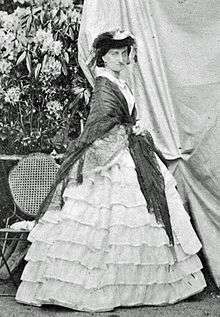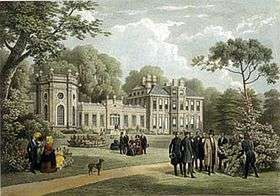Princess Maria Carolina of Bourbon-Two Sicilies (1822–1869)
| Princess Maria Carolina | |||||
|---|---|---|---|---|---|
| Duchess of Aumale | |||||
 | |||||
| Born |
26 April 1822 Vienna, Austrian Empire | ||||
| Died |
6 December 1869 (aged 47) Twickenham, London, England | ||||
| Burial | Chapelle royale de Dreux | ||||
| Spouse | Prince Henri, Duke of Aumale | ||||
| Issue |
Louis, Prince of Condé François Louis, Duke of Guise | ||||
| |||||
| House | Bourbon-Two Sicilies | ||||
| Father | Leopold, Prince of Salerno | ||||
| Mother | Archduchess Maria Clementina of Austria | ||||
| Religion | Roman Catholic | ||||
| Signature |
| ||||
Princess Maria Carolina Augusta of Bourbon-Two Sicilies[1][2] (born 26 April 1822 in Vienna, Austrian Empire;[1][2] died 6 December 1869 in Twickenham, London, England,[1][2]) was a Princess of Bourbon-Two Sicilies by birth and a princess of the House of Orléans through her marriage to Prince Henry of Orléans, Duke of Aumale.
Life
Youth and Marriage
Maria Carolina was born in Vienna on 26 April 1822, the only surviving child of Prince Leopold of Bourbon-Two Sicilies, Prince of Salerno and his wife (and niece) Archduchess Maria Clementina of Austria, daughter of Francis II, Holy Roman Emperor.[1][2]
Nicknamed Lina since her birth, the princess spent the first years of her life under the supervision of her mother in the Austrian imperial court at Vienna and was also officially introduced there in society. As a teenager, she returned with her family to Naples.
In the 1830s and 1840s there were not many princesses from European nobility who were in a marriageable age, so Maria Carolina had several suitors for her hand. The choice finally fell on Prince Henry, Duke of Aumale, fifth and second youngest son of King Louis-Philippe I of France and his wife Maria Amalia of the Two Sicilies, who became impressed with her during a stay at her father's palace in Naples.[3] The marriage negotiations began in late August 1844, and already on 17 September of the same year at the Revue de Paris, their engagement was officially announced.[4] The union was anything but a love match. Henri d'Orléans described his wife in a letter to his teacher Alfred-Auguste de Cuvillier-Fleury as "not nice, but nothing unpleasant about herself".[5] Cuvillier-Fleury agreed with him, adding that she also had an "exquisite appearance" ("[...] n'est pas jolie, mais c'est une miniature exquise.").[6] Henry agreed with the marriage only after intense pressure from his parents after they rejected other candidates and finally opted for the small and graceful Maria Carolina to forestall any other marriage proposals to her from other European princes.
The marriage took place on 25 November 1844 (the date corresponded to the wedding anniversary of the French royal couple) in Naples[1][2] at the request of the groom, although Maria Carolina's future in-laws would have preferred it that the marriage would be celebrated in Paris. The civil wedding was performed in the royal palace of King Ferdinand II of the Two Sicilies, and on the same day the religious ceremony was celebrated with great pomp. The bride received the large amount of 517,000 gold francs as a dowry.[7] The festivities on the occasion of the wedding, such as balls, receptions, hunting events or theater galas, lasted more than two weeks.[4] However, Maria Carolina traveled already on 2 December 1844 together with her husband by ship to Toulon. From there the newlyweds had a grand reception by the city to Paris, where they settled in a serie of rooms at the Tuileries Palace.
First years of marriage and issue
During the first months of 1845, which for Maria Carolina where filled by ceremonial duties at official occasions such as balls, theatrical performances or meetings with nobles, she and her husband had finally the opportunity to know each other better. They developed a mutual respect, and during all her life the princess was a faithful and devoted wife who never made claims.[8] Her charming ways, gentleness and kindness gained the love of her husband's family.[9] Contemporaries described her as amiable and witty ( "[...] on la dit gentille, spirituelle; [...]").[10] In May 1845 she moved with her husband to the Château de Chantilly, which Henry specially made rebuild and modernize.
Maria Karolina remained at her husband's side after he was appointed in September 1847 Governor General of Algeria and therefore his presence in that country was necessary.
Exile in England. Death
After the February Revolution of 1848 The Orléans family went into exile in England and by decree from 16 May 1848, permanently banned from France. Maria Carolina followed her husband and they temporarily moved to Claremont House settled. Their strain finances forced the princess to sold parts of their precious jewels their maintenance.

Maria Carolina soon become a close friend of the Queen Victoria,[11] who gave her and her family the called Orléans House in Twickenham, London as their residence; they moved from Claremont to their new home on 16 April 1852.[12] After a long journey in August 1864 across Europe (including Belgium, Germany, Austria, Hungary, Spain, Switzerland and the Orient) Maria Carolina preferably spent her time in the Wood Norton Hall estate at Worcestershire.
The unexpected death of her eldest son Louis Philippe, Prince of Condé in 1866 plunged Maria Carolina into a deep depression from which she never fully recovered.[13] After a six-week of illness,[13] she died on 6 December 1869 aged 47 at Orleans House from infectious tuberculosis.
Four days after her death, on 10 December 1869, Maria Carolina was buried in the Catholic Chapel of Weybridge until 1876, when her remains were returned to France by her husband to be buried in the Chapelle royale de Dreux. After the death of his wife, Henry preferred to remain a widower until his own death in 1897.
Issue
Maria Carolina and Henry had seven children, from only two survived childbirth but both died young:[1][2]
- Louis Philippe Marie Léopold d'Orléans, Prince of Condé (15 November 1845 – 24 May 1866).[14]
- Henri Léopold Philippe Marie d'Orléans, Duke of Guise (11 September 1847 – 10 October 1847).[15]
- Stillborn daughter (1849).
- François Paul d'Orléans, Duke of Guise (11 January 1852 – 15 April 1852).[15]
- François Louis Philippe Marie d'Orléans, Duke of Guise (5 January 1854 – 25 July 1872).[14]
- Stillborn son (15 June 1861).
- Stillborn son (June 1864).
Titles, styles, honours and arms
Titles and styles
- 26 April 1822 – 25 November 1844: Her Royal Highness Princess Maria Carolina Augusta of Bourbon-Two Sicilies
- 25 November 1844 – 6 December 1869: Her Royal Highness The Duchess of Aumale, Princess of France, Princess of Bourbon-Two Sicilies
Ancestry
References
- 1 2 3 4 5 6 Darryl Lundy (10 March 2007). "Maria Carolina Auguste di Borbone, Principessa di Borbone delle Due Sicilie". thepeerage.com. Retrieved 6 October 2008.
- 1 2 3 4 5 6 Paul Theroff. "TWO SICILIES". Paul Theroff's Royal Genealogy Site. Retrieved 5 October 2008.
- ↑ Cazelles, p. 106.
- 1 2 Woerth, p. 71.
- ↑ Woerth, note p. 70.
- ↑ Cazelles, note p. 111.
- ↑ Cazelles, p. 157.
- ↑ Cazelles, p. 114.
- ↑ Woerth, p. 73.
- ↑ Cazelles, note p. 102.
- ↑ Cazelles, p. 282.
- ↑ Woerth, p. 266.
- 1 2 Obituary of HRH The Duchess d'Aumâle, The Times 8 December 1869. [retrieved 12 September 2016].
- 1 2 Jirí Louda, Michael MacLagan: Lines of Succession: Heraldry of the Royal Families of Europe, 2nd edition. Little, Brown and Company, London 1999, vol. 70.
- 1 2 Hugh Montgomery-Massingberd (ed.): Burke’s Royal Families of the World, vol 1: Europe & Latin America. Burke’s Peerage Ltd., London 1977, p. 92.
Bibliography
- Raymond Cazelles: Le duc d’Aumale. Prince aus dix visages. Tallandier, Paris 1984, ISBN 2-235-01603-0, pp. 98–115, 279–282.
- Alfred-Auguste de Cuvillier-Fleury: Marie-Caroline Auguste de Bourbon, duchesse d’Aumale, 1822–1869. C. Lahure, Paris 1870. online
- Eric Woerth: Le duc d’Aumale. L'étonnant destin d’un prince collectionneur. L’Archipel, Paris 2006, ISBN 2-84187-839-2, pp. 65–82.
External links
![]() Media related to Princess Maria Carolina of Bourbon-Two Sicilies (1822–1869) at Wikimedia Commons
Media related to Princess Maria Carolina of Bourbon-Two Sicilies (1822–1869) at Wikimedia Commons
